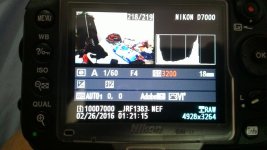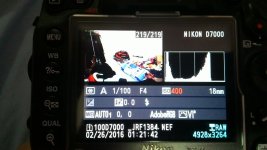This is like a poll. I would appreciate your doing this simple little test, and letting me know your Auto ISO result with flash for your Nikon DSLR camera model... either with response here or via PM. Just two quickie pictures, then look at ISO. I don't need to see any pictures.
This can only use a hot shoe flash in TTL mode... NOT the internal flash, and NOT a manual flash.
With Auto ISO on, a Minimum ISO 100 or 200, and Maximum like ISO 2000 or 3200 would be great.
And Normal camera settings, just something like f/4 in camera A mode. Exact values not critical.
Take a quick snapshot of any regular indoor picture (regular room lighting, but not bright, fairly dim), without flash (with hot shoe TTL flash turned off ... no flash). Of anything, a chair or wall or something, the picture itself is of no importance, it should just be high ISO (in room not too bright).
Then reach up and turn TTL flash on and take the same picture.
Then the actual ISO used can be seen on the camera rear LCD in the data (see note about seeing ISO below at bottom).
High ISO is expected in the first picture without flash. The goal is a not too bright place so it will be a high ISO.
Then for the second picture with TTL flash, Nikon DSLR are in three groups (groups are a name I made up) about what the Auto ISO with hot shoe TTL flash will do.
I'd really like to hear your model and results of this group. And if it is a correction, then more details would be great, about modes and settings and flash, just to be very clear.
This list is my notion of what will happen. I think the list is near correct, but I hope to verify several models in the list, via your test result, particularly near group divisions. Certainly any corrections are of extreme interest. Any help will be greatly appreciated. Nikon does not put this action in the specs, and they have changed it a couple of times, so I have guessed at a bit of it.
Nikon DSLR - Auto ISO action with TTL hot shoe flash indoors
Group A - ISO stays at Minimum ISO with hot shoe TTL flash.
D2H Jul 2003
D70 Feb 2004
D70S May 2005
D200 Nov 2005
D80 Aug 2006
D40 Nov 2006
D300 Jul 2007
D3 Jul 2007
D60 Jan 2008
D700 Jul 2008
D90 Aug 2008
Group B - ISO stays at high ISO for dim ambient with hot shoe TTL flash.
D5000 Apr 2009 ?
D300S Jul 2009
D3000 Jul 2009
D3S Oct 2009
D3100 Aug 2010 ?
EDIT: moved a few to Group C.
Group C - Auto ISO increases 2 stops (to 4x Minimum ISO), with hot shoe TTL flash
D7000 Sep 2010 * moved
D5100 Apr 2011 *
D3200 Apr 2012 *
D5200 Nov 2012 *
D4 Jan 2012
D800 Mar 2012
D600 Sep 2012
D7100 Feb 2013 *
D610 Oct 2013
D5300 Oct 2013 *
D3300 Jan 2014 *
D810 Jun 2014
D750 Sep 2014
D5500 Jan 2015 *
D810A Feb 2015
D7200 Apr 2015 *
If any question about seeing ISO: ISO is seen on rear LCD in playback. Show the previous picture, then the selector up/down arrows scroll though several data screens (camera manual shows them under Playback). A couple of these screens show data including ISO. Auto ISO value is probably Red. Here is what one of mine looks like, it shows camera A mode, ISO 3200. And f/4, etc. This was a picture of a closet door in a not very bright room, without flash. The goal is a high ISO without flash, and then to see ISO when TTL flash is turned on and used.
Thanks very much for your help.

FWIW, some ifs and buts about other cases.
The internal TTL flash is same ISO action for group A and B, but internal flash Auto ISO stays high in group C. Lower power needs it I suppose.
Manual flash can never increase ISO (assuming the camera can recognize it is present). Manual flash cannot react to Auto ISO changes.
Likewise, use of Commander in any model never increases ISO, TTL or Manual.
An off camera flash, or a flash brand that is not recognized present by the camera, will not prevent Auto ISO increases. Auto ISO must be turned off for manual flash.
Group A can increase ISO, but only at last instant if it deems the flash has insufficient power for the exposure. Like doomed bounce attempts at f/22 probably will increase ISO. So I suggest f/4 direct flash for this test.
And note that the single gray histogram shown on this screen is the B&W luminance histogram, which will not show clipping, so is totally useless in that regard. We should ONLY look at the three RGB histograms if concerning clipping (on a different screen here).
This can only use a hot shoe flash in TTL mode... NOT the internal flash, and NOT a manual flash.
With Auto ISO on, a Minimum ISO 100 or 200, and Maximum like ISO 2000 or 3200 would be great.
And Normal camera settings, just something like f/4 in camera A mode. Exact values not critical.
Take a quick snapshot of any regular indoor picture (regular room lighting, but not bright, fairly dim), without flash (with hot shoe TTL flash turned off ... no flash). Of anything, a chair or wall or something, the picture itself is of no importance, it should just be high ISO (in room not too bright).
Then reach up and turn TTL flash on and take the same picture.
Then the actual ISO used can be seen on the camera rear LCD in the data (see note about seeing ISO below at bottom).
High ISO is expected in the first picture without flash. The goal is a not too bright place so it will be a high ISO.
Then for the second picture with TTL flash, Nikon DSLR are in three groups (groups are a name I made up) about what the Auto ISO with hot shoe TTL flash will do.
- Group A - ISO with flash will remain at Minimum ISO. Auto ISO will not increase if hot shoe TTL flash is present.
- Group B - ISO with flash will be high with flash, about same high maximum ISO with or without flash.
- Group C - ISO with flash will increase only two stops... to 4x minimum ISO value, if with flash. For example Minimum ISO 100 will go only to ISO 400 if TTL hot shoe flash is present.
I'd really like to hear your model and results of this group. And if it is a correction, then more details would be great, about modes and settings and flash, just to be very clear.
This list is my notion of what will happen. I think the list is near correct, but I hope to verify several models in the list, via your test result, particularly near group divisions. Certainly any corrections are of extreme interest. Any help will be greatly appreciated. Nikon does not put this action in the specs, and they have changed it a couple of times, so I have guessed at a bit of it.
Nikon DSLR - Auto ISO action with TTL hot shoe flash indoors
Group A - ISO stays at Minimum ISO with hot shoe TTL flash.
D2H Jul 2003
D70 Feb 2004
D70S May 2005
D200 Nov 2005
D80 Aug 2006
D40 Nov 2006
D300 Jul 2007
D3 Jul 2007
D60 Jan 2008
D700 Jul 2008
D90 Aug 2008
Group B - ISO stays at high ISO for dim ambient with hot shoe TTL flash.
D5000 Apr 2009 ?
D300S Jul 2009
D3000 Jul 2009
D3S Oct 2009
D3100 Aug 2010 ?
EDIT: moved a few to Group C.
Group C - Auto ISO increases 2 stops (to 4x Minimum ISO), with hot shoe TTL flash
D7000 Sep 2010 * moved
D5100 Apr 2011 *
D3200 Apr 2012 *
D5200 Nov 2012 *
D4 Jan 2012
D800 Mar 2012
D600 Sep 2012
D7100 Feb 2013 *
D610 Oct 2013
D5300 Oct 2013 *
D3300 Jan 2014 *
D810 Jun 2014
D750 Sep 2014
D5500 Jan 2015 *
D810A Feb 2015
D7200 Apr 2015 *
If any question about seeing ISO: ISO is seen on rear LCD in playback. Show the previous picture, then the selector up/down arrows scroll though several data screens (camera manual shows them under Playback). A couple of these screens show data including ISO. Auto ISO value is probably Red. Here is what one of mine looks like, it shows camera A mode, ISO 3200. And f/4, etc. This was a picture of a closet door in a not very bright room, without flash. The goal is a high ISO without flash, and then to see ISO when TTL flash is turned on and used.
Thanks very much for your help.

FWIW, some ifs and buts about other cases.
The internal TTL flash is same ISO action for group A and B, but internal flash Auto ISO stays high in group C. Lower power needs it I suppose.
Manual flash can never increase ISO (assuming the camera can recognize it is present). Manual flash cannot react to Auto ISO changes.
Likewise, use of Commander in any model never increases ISO, TTL or Manual.
An off camera flash, or a flash brand that is not recognized present by the camera, will not prevent Auto ISO increases. Auto ISO must be turned off for manual flash.
Group A can increase ISO, but only at last instant if it deems the flash has insufficient power for the exposure. Like doomed bounce attempts at f/22 probably will increase ISO. So I suggest f/4 direct flash for this test.
And note that the single gray histogram shown on this screen is the B&W luminance histogram, which will not show clipping, so is totally useless in that regard. We should ONLY look at the three RGB histograms if concerning clipping (on a different screen here).
Last edited:


